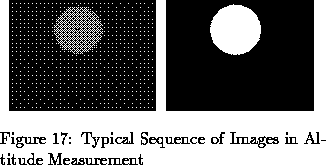


Next: Obtaining GP of
Up: Obtaining Circles of
Previous: Obtaining Circles of
Sun images are sent to a workstation,
which performs the following operations:
- A histogram is made with the pixel values, and
the image is thresholded so that only 20%of pixels remain valid.
- A grassfire transform is performed in order to remove noisy
features in the thresholded image.
- A region coloring algorithm is used to connect all remaining regions
in the thresholded image. The algorithm scans the image and expands every
region as much as possible.
- Each connected region is analyzed.
The best region based on area and aspect ratio
is declared to be the Sun image.
- The centroid of the chosen region is calculated and reported as
the position of the Sun in the image.
Figure 17 shows a typical sequence of images generated
by the system.
The first image is the raw image obtained using the neutral
density filters and the telephoto lens. The centroid determined by the
system is marked with a cross in this image.
The second image is the thresholded and filtered image.



The determination of the centroid of the Sun allows us to obtain the angle between
the optical axis and the ray that emanates from the center of the image to the
Sun. This angle is:
 where:
where:

- Row of centroid of Sun (in pixels).

- Row of center of image (in pixels).

- Focal length in camera's
 axis (in pixels).
axis (in pixels).
The parameters  and
and  are intrinsic
parameters of the camera and their values were obtained through a
customized calibration procedure. Details of this procedure are left to
Section 3.4.
are intrinsic
parameters of the camera and their values were obtained through a
customized calibration procedure. Details of this procedure are left to
Section 3.4.
In order to get altitude, we need to obtain the angle between the
optical axis of the camera and the horizontal plane with respect
to Earth's gravity. This angle is measured with a digital inclinometer.
Raw altitude is given by:
 where
where  is the inclinometer reading.
is the inclinometer reading.
There are some additional factors that must be taken into account in this
type of measurement [7].
The gradual bending of an incoming
light ray in the Earth's atmosphere is called atmospheric refraction;
it must be corrected. Atmospheric refraction depends on the raw altitude,
because rays bend in different ways when they reach the atmosphere at
different angles. The refraction correction  in degrees is given by:
in degrees is given by:
 The difference in the apparent altitude of a body within the
solar system as viewed from the surface of Earth and from its center is
called parallax; this difference must be corrected since the images of the Sun are
taken from its surface, not from its center. The parallax correction
The difference in the apparent altitude of a body within the
solar system as viewed from the surface of Earth and from its center is
called parallax; this difference must be corrected since the images of the Sun are
taken from its surface, not from its center. The parallax correction  for the Sun is:
for the Sun is:
 The final observed altitude is
The final observed altitude is  .
.



Next: Obtaining GP of
Up: Obtaining Circles of
Previous: Obtaining Circles of
where:
where
is the inclinometer reading.
in degrees is given by:
The difference in the apparent altitude of a body within the
solar system as viewed from the surface of Earth and from its center is
called parallax; this difference must be corrected since the images of the Sun are
taken from its surface, not from its center. The parallax correction
for the Sun is:
The final observed altitude is
.